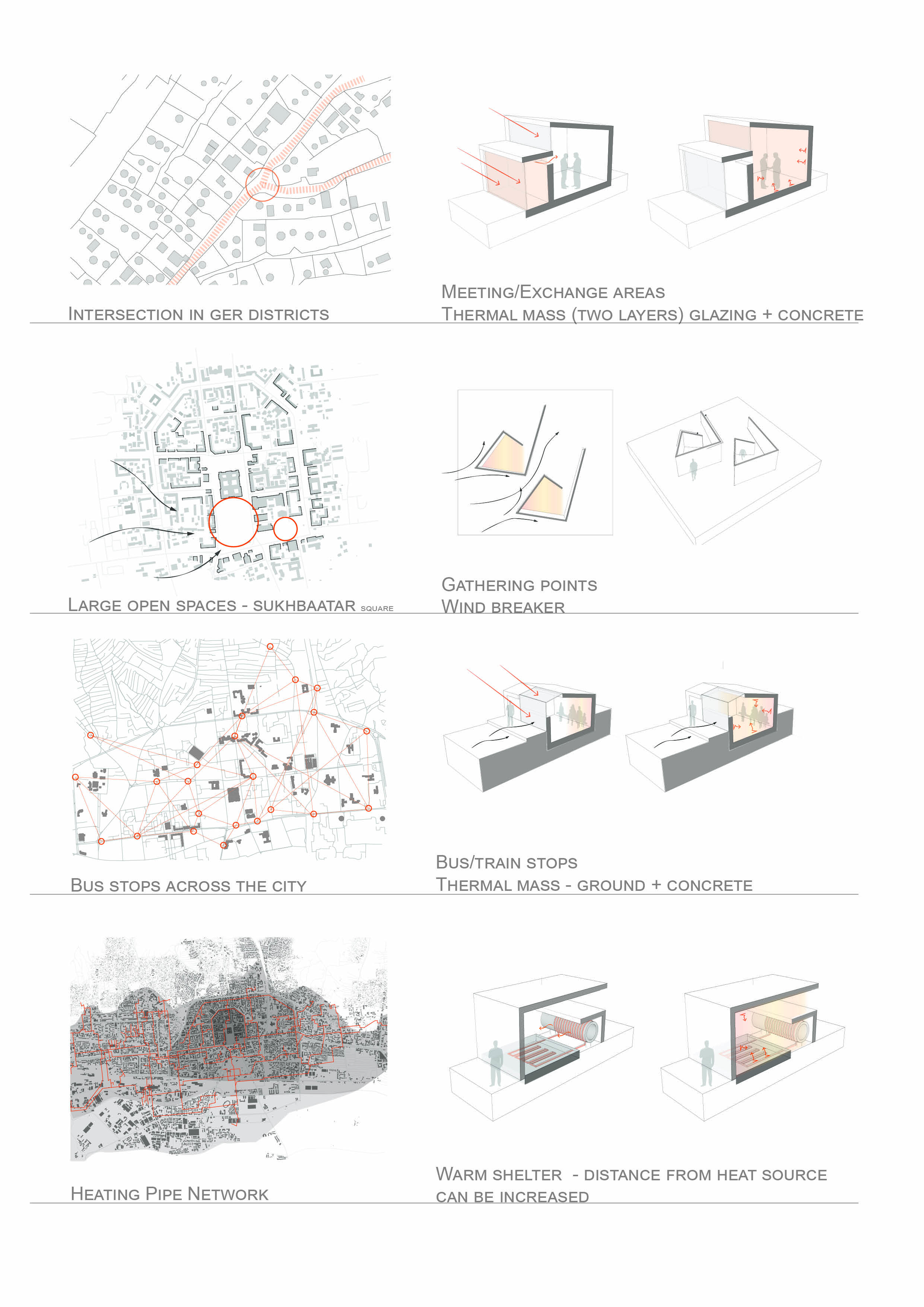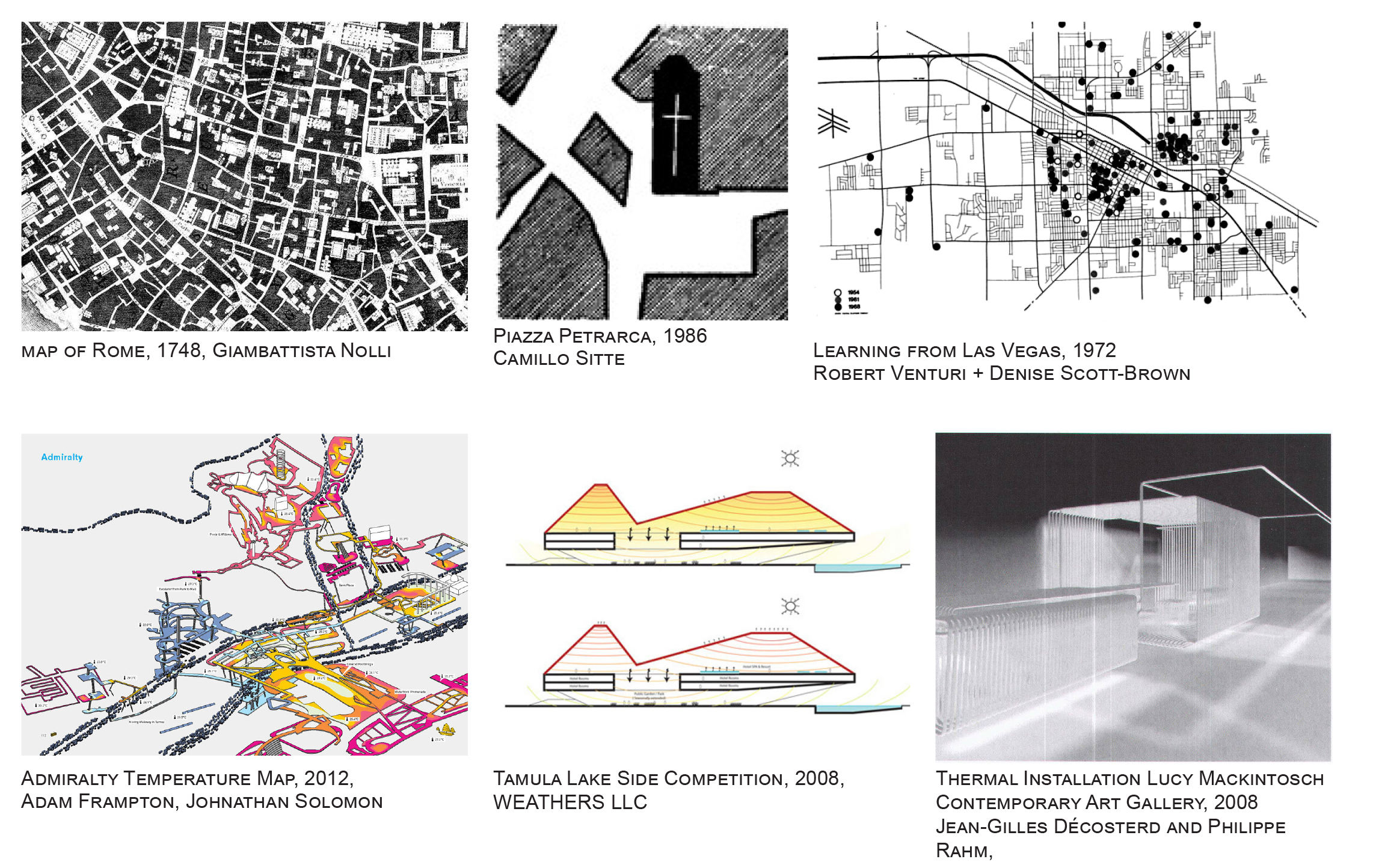|
 This thesis will explore the relationship between people and community spaces through climate. Because the climate is something which is shared by all buildings and spaces within a city, it affects how spaces are used and how they should be designed. The thesis aims to develop a method of analysing that is driven by the use, climate, and cultural context, then based on this to generate a design strategy which is integrated and specific to urban and site conditions. This thesis will explore the relationship between people and community spaces through climate. Because the climate is something which is shared by all buildings and spaces within a city, it affects how spaces are used and how they should be designed. The thesis aims to develop a method of analysing that is driven by the use, climate, and cultural context, then based on this to generate a design strategy which is integrated and specific to urban and site conditions.
WHAT?

SITE/SCOPE/SCALE
Architecturally, community spaces are designed as places where people gather and generate something more, the test site will need to have a variety of civic spaces but it should not have a strong preconceived idea of what makes a good shared space to allow the thesis to understand how the existing city works with the people. The cultural and climatic identity of the site will also need to be very strong to allow the thesis to showcase how the methodology can understand how to make shared spaces specific to the urban and cultural needs.
REASON FOR SITE SELECTION AND TEST CASES
Ulaanbaatar, Mongolia, fits all of these criteria. It has a strong cultural and political past that it is trying to reconcile between, a different approach to property rights, a nomadic community, and a distinctive climate. The temperatures are too low for people to gather outside for most part of the year, so the test cases will experiment with different thermal and programmatic strategies. The long and cold winters affect the how people use spaces and reduce the interactions between them, posing an immediate question about how public spaces can work in these conditions as there isn’t a clear view of what the ideal public space should be. The ger districts and communities that live there becomes a test case for the thesis to focus on, allowing it to develop a strategy that redefines our understanding of relationships between the community and climate.
WHY?

Discourses on public space are closely related to the desired image of the city and the distinction between public and private. Architects have always designed them and used them as a tool to represent their idealised city. Nolli contrasted the street and public structures against private elements, focusing on how the public operates separately. Piranesi and Rowe used history as a tool to study the composition of spaces. Gehl considers spaces in terms of opposites to define how in-between spaces can be designed. However, these methods do not take the specificity of the context and uses into account.
When discourses become more interdisciplinary and analytical, we begin to understand how space is perceived and used, and how we can design with this. Lynch and Atelier Bow-Wow use perception as a way of studying the city – through memories and un-designed buildings. Venturi and Scott-Brown, and Frampton and Solomon’s analysis are the most context driven – using specific cities to illustrate communication of social values, or the layers beyond the ground plane.
Analysis on public space based on the preconceived notion that there has to be a differentiation between public and private does not work. It is more about how the context and the use affect how and what spaces should be designed as there are different degrees of ‘public-ness’. At the end of his book, Frampton and Solomon briefly touch upon how temperature and the atmosphere of spaces are linked. This thesis will explore the relationship between people and community spaces through climate. Because the climate is something which is shared by all buildings and spaces within a city, it affects how spaces are used and how they should be designed. The thesis aims to develop a method of analysing that is driven by the use, climate, and cultural context, then based on this to generate a design strategy which is integrated and specific to urban and site conditions.
HOW?

Through a series of analysis – such as looking at the micro-climate of existing civic building through thermal sections, mapping the intended and realised use of spaces for different seasons, and interviewing locals – the thesis will develop a methodology to identify potential points of intervention in Ulaanbaatar. The second stage will be to explore different strategies and develop a design based on these findings.
Step 01 – Initial Research and Studies – Due by Review 1.0
1. Identification and cataloguing how architects and theorists embed larger ideas of public space in their work, and the analytical methods that they employ.
2. Site research (history, culture, and climate) and initial research into low tech thermal strategies.
Step 02 – Site Visit
1. Collect data and to test strategies.
2. Study and record data on chow climate affects use of civic infrastructure and public spaces.
3. Interview locals to further understand cultural perception.
Step 03 – Further Research and Preliminary Design – Due by Review 2.0
1. Analysis of information collected from the site visit to determine the focus of the design intervention.
2. Further research into technological strategies as design and experimentation begins.
Output will consist of analytical drawings and models – scale to be determined.
Step 04 – Design Development – Due by Review 3.0
1.Continuation of the design project, testing of different iterations and developing the proposal in more detail. Output will consist of design drawings and models – a large scale than in Step 03.
Step 05 – Refinement – Due by Final Review
1. Refinement of design and drawings on a larger scale.
BIBLIOGRAPHY
THEORY
1. Jacobs, Jane. “The Peculiar Nature of Cities.” The Death and Life of Great American Cities. New York: Random House, 1961. 37-186.
2. Sennett, Richard. “The Public Realm.” The Blackwell City Reader. By Gary Bridge and Sophie Watson. Malden, MA: Blackwell Pub., 2002. 261-72.
3. Low, Setha M., and Neil Smith. “The Imperative of Public Space.” Introduction. The Politics of Public Space. New York: Routledge, 2006. 1-16.
4. Le Corbusier. “The Prevailing Condition of the Cities.” The Athens Charter. New York: Grossman, 1973. 51-91.
TECHNIQUES
1. Venturi, Robert, Denise Scott Brown, and Steven Izenour. Learning from Las Vegas. Cambridge, MIT, 1977.
2. Gehl, Jan. Life between Buildings Using Public Space. Washington, DC: Island, 2011.
3. Rowe, Colin, and Fred Koetter. Collage City. Cambridge, MA: MIT, 1978.
4. Sitte Camillo. The Birth of Modern City Planning, New York: Rizzoli, 1986
5. Lynch, Kevin. The Image of the City. Cambridge, MA: MIT, 1960
6. Rahm, Philippe, and Jean-Gilles Décosterd. “5. Thermal Distortion.”Décosterd & Rahm, Distorsions: Architecture 2000-2005 = Décosterd & Rahm, Distortions: Architecture 2000-2005. Orléans: Hyx, 2005.
7. Frampton, Adam, Clara Wong, and Jonathan Solomon. “Atmosphere.” Cities without Ground: A Hong Kong Guidebook. Oro Editions, 2012
8. Kaijima, Momoyo, Junzo Kuroda, and Yoshiharu Tsukamoto. Made in Tokyo. Tokyo: Kajima Inst. Publ., 2012
PROJECTS
1. Plan Voisin, Paris, France, Le Corbusier , 1925
2. Aldo van Eyck, Amsterdam Orphanage, Amsterdam, Netherlands, 1960
3. Richard Rogers, Renzo Piano, Pompidou Centre, Paris, France, 1977
4. James Corner, NYC Highline Park, New York, USA, 1993
5. Rem Koolhaas, IIT Mc Cormick Tribune Campus Centre, Illinois, USA, 2003
6. WEATHERS LLC and Morris Architects, Tamula Lake Side Competition, Voru, Estonia, 2008
7. Jean-Gilles Décosterd and Philippe Rahm, Thermal Installation Lucy Mackintosch Contemporary Art Gallery, Lausanne, Switzerland, 2005
|
 This thesis will explore the relationship between people and community spaces through climate. Because the climate is something which is shared by all buildings and spaces within a city, it affects how spaces are used and how they should be designed. The thesis aims to develop a method of analysing that is driven by the use, climate, and cultural context, then based on this to generate a design strategy which is integrated and specific to urban and site conditions.
This thesis will explore the relationship between people and community spaces through climate. Because the climate is something which is shared by all buildings and spaces within a city, it affects how spaces are used and how they should be designed. The thesis aims to develop a method of analysing that is driven by the use, climate, and cultural context, then based on this to generate a design strategy which is integrated and specific to urban and site conditions.

